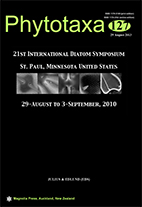Abstract
There are substantial ecological and evolutionary costs to sexual reproduction and there is only a narrow range of conditions that favors the evolution of high rates of sexual reproduction in species that are capable of both sexual and asexual reproduction. Considering the evolutionary costs and benefits of sexual reproduction, it was hypothesized that the frequency of sexual reproduction relative to asexual reproduction in diatoms would be greater for attached pennates and lower for planktonic centrics. This was investigated by comparison of the size-class distributions of the attached pennate, Rhopalodia gibba (Ehrenberg) Müller 1895 and the planktonic centric Cyclotella meneghiniana Kützing 1844 collected from the littoral zone of Lake Phalen in St. Paul Minnesota, USA. Numerical combination of binomial functions was used to infer the number of significant occurrences of sexual reproduction contributing to the size-class distribution of each population, with the frequency of sexual reproduction relative to asexual reproduction inferred from the number of binomial curves contributing to the distribution. The size-class profile of C. meneghiniana was unimodal, dominated by a single peak at 12 µm, with additional contributing curves with peaks at 15 µm and 18 µm. The size-class profile of R. gibba was bimodal, dominated by peaks at 46 µm and 60 µm, with additional contributing curves with peaks at 36 µm, 73 µm, and 84 µm. The results of this investigation were robust with respect to difference between the species in sample size and number of size-classes, although the analysis method is sensitive to differences in the number of size-classes. The results supported the hypothesis, and demonstrate the principle that size-class analysis of diatom populations can be used to investigate evolutionary hypotheses about differences among taxa in the relative frequency of sexual and asexual reproduction.

